#Painting Tools Market by Type
Text
Painting Tools Market Predicted to Witness Steady Growth by 2028
The painting tools market is expected to register notable gains by 2028 due to the expanding automotive industry across the globe.
Painting and coatings make products visually appealing and provide an added layer of protection and durability to products without adding any significant weight. Prevalent use of painting and coatings in varied applications has bolstered product uptake in recent years. Additionally, increasing adoption of flexible packaging solutions that utilize coated barrier systems, which enhance the recyclability and reusability of the packaging, has propelled market expansion.
Get sample copy of this research report @ https://www.gminsights.com/request-sample/detail/1843
The painting tools market has been segmented based on application, product, and region. With respect to product, the market has further been bifurcated into masking tapes, brushes, spray gun, rollers, trays, scrapers, knives, and others (extension poles, sanding tools, trowels).
The brushes sub-segment is projected to grow at a CAGR of around 5.4% in terms of revenue over the assessment period. Paint brushes are one of the most fundamental and oldest tools that are used for painting. Brushes are utilized to paint corners, walls, and ceilings, which is not possible with rollers and spray guns. Paint brushes are classified on the basis of types of bristles, shapes, and sizes. Surging demand for paint brushes with high-quality natural or synthetic bristles that deliver a smooth finish and provide a comfortable grip is likely to drive segmental growth in the forthcoming years.
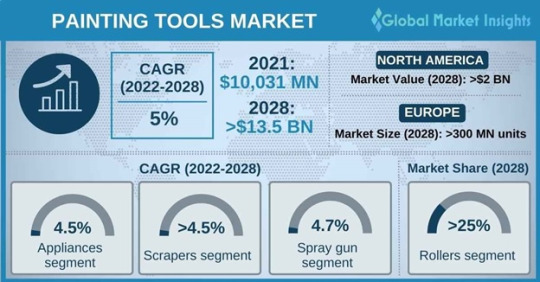
From the application perspective, the painting tools market has been divided into packaging, construction, industrial machineries & equipment, residential, furniture, commercial, appliances, industrial, and automotive.
The packaging sub-segment is slated to reach a substantial valuation by 2028, expanding at a CAGR of approximately 3% through the review timeline. Paints and coatings provide all the features required for primary and secondary packing, including high performance, lightweight, low contamination, and airtightness. Packaging items use about 70% less plastic as well as take up lesser space than rigid packaging options. In addition, the use of improved paints and coatings on these packaging helps in protecting the goods from outside influences, which is estimated to boost product demand over the forthcoming years.
Request for customization @ https://www.gminsights.com/roc/1843
On the regional front, the Middle East & Africa painting tools market is poised to see robust expansion at a CAGR of more than 4.5% over the forecast period owing to high infrastructure spending and widespread post-war construction activities. The MEA painting tools market is dominated by Saudi Arabia and South Africa in terms of market share, with Saudi Arabia emerging as the fastest expanding market in the region. Notably, the booming domestic construction industry would bolster paint consumption, which is likely to drive regional market growth. Moreover, economic diversification and the growing tourism sector in the region are set to augment industry uptake over the upcoming years.
Table of Contents (ToC) of the report:
Chapter 1 Methodology and Scope
1.1 Market definitions
1.2 Base estimation & working
1.2.1 North America
1.2.2 Europe
1.2.3 Asia Pacific (APAC)
1.2.4 Latin America (LATAM)
1.2.5 Middle East & Africa (MEA)
1.3 Forecast calculations
1.3.1 COVID-19 impact calculations on industry forecast
1.4 Data Sources
1.4.1 Primary
1.4.2 Secondary
Chapter 2 Executive Summary
2.1 Global Painting Tools industry 360° synopsis, 2018 – 2028
2.1.1 Business trends
2.1.2 Product trends
2.1.3 Application trends
2.1.4 Regional trends
Browse complete Table of Contents (ToC) of this research report @ https://www.gminsights.com/toc/detail/painting-tools-market
HVAC & Construction Research Reports
Vacuum Pumps Market
Positive Displacement Blowers Market
Centrifugal Blower Market
About Global Market Insights:
Global Market Insights, Inc., headquartered in Delaware, U.S., is a global market research and consulting service provider; offering syndicated and custom research reports along with growth consulting services. Our business intelligence and industry research reports offer clients with penetrative insights and actionable market data specially designed and presented to aid strategic decision making. These exhaustive reports are designed via a proprietary research methodology and are available for key industries such as chemicals, advanced materials, technology, renewable energy and biotechnology.
Contact Us:
Aashit Tiwari
Corporate Sales, USA
Global Market Insights Inc.
Toll Free: 1-888-689-0688
USA: +1-302-846-7766
Europe: +44-742-759-8484
APAC: +65-3129-7718
Email: [email protected]
#Painting Tools Market Analysis#Painting Tools Market by Type#Painting Tools Market Share#Painting Tools Market Development
0 notes
Photo

Black Figure Pottery
Black Figure Pottery is a type of Greek pottery named after the colour of the scenes painted on vessels. It was first produced in Corinth c. 700 BCE and then adopted by pottery painters in Attica, where it would become the dominant decorative style from 625 BCE. Athenian vases then dominated the Mediterranean pottery market for the next 150 years.
Besides Attica and Corinth, Laconia was a third, albeit minor, producer of the style in the first half of the 6th century BCE. The more than 20,000 surviving black figure vases and vessels of varied form make it possible not only to identify artists and studios, but they also provide the oldest and most diverse representations of Greek mythology, battle scenes, and religious, social, and sporting practices. The pottery vessels are also an important tool in determining the chronology of archaeological sites and the history of ancient Greece in general. The style was eventually replaced by red-figure pottery.
Development
Evolving from the earlier geometric designs on pottery, the black-figure technique depicted animals (more favoured in Corinth) and human silhouette figures (preferred by Athenian painters) in naturalistic detail. Before the firing process, a brilliant black pigment of potash, iron clay, and vinegar (as a fixative) was thickly applied to entire vases or part of the vessel. This black gloss also gave a slight relief effect. Parts of the painted area were then scraped away where not required, leaving a design in silhouette. Additional details such as muscles and hair were added to the figures using a sharp instrument to incise through the black to reveal the clay vessel beneath and by adding touches of red and white paint. Vessel borders and edges were often decorated with floral, lotus, and palmette designs.
Continue reading...
69 notes
·
View notes
Text
Writing Analysis: Of Mice and Men (Cultural References)
Bindle: A bag, sack, or carrying device.
Bindle Stiff: Hobo; transient who carries his belongings in a sack.
Bunk House: A sleeping quarters intended for use by multiple people.
Talcum Powder: Very similar in texture to baby powder, talcum powder was used mainly after bathing or shaving.
Apple Box: A box used for storage or as a stepstool capable of holding a person's weight.
Scourges: A widespread affliction, an epidemic illness or the consequence of some natural disaster, like fire, flood, or a migration of locusts.
Pants Rabbits: A sexually transmitted disease, known as pubic lice.
Graybacks: The equivalent of ticks or lice.
Liniment: A topical cream for the skin that helps with pain or rashes.
Jerkline Skinner: Lead driver of a team of mules
Stable Buck: A derogatory name for an African-American man who works in the stables.
Stetson Hat: A famous brand of hats, especially cowboy hats.
Swamper: A general assistant; handyman.
Murray and Ready: An employment agency, specializing in farm work.
Work Slips: Proof that people had been hired to do a job.
Cultivator: A farming tool used to stir and soften the soil either before or after planting.
Cesspool: A well or pit filled with drainage or sewage.
Slough: A muddy or marshy area.
Tart: A woman who tempts men or who is sexually promiscuous.
Buck Barley: To throw large bags of barley on a truck.
Lynch: To illegally execute a person, generally applied to the hanging and/or burning of African-Americans in the south.
Slug of Whiskey: Equivalent to a hip flask of whiskey.
Gut Ache: A stomach ache.
Airedale: A type of dog, specifically Terrier.
Pulp Magazine: During the 1920s-1950s, inexpensive fiction magazines. From 1950 on, the term also came to represent mass market paperbacks.
Luger: The Luger pistol was an expensive, high maintenance weapon manufactured and used primarily in the German army.
Euchre: A card game played in England, Canada, and some parts of the U.S.
Two Bits: Twenty-Five cents.
Rag Rug: Rugs created from rags that were tied together by knots.
Kewpie Doll: A particular style of doll, one that was usually won at carnivals.
Phonograph: The first device for recording and playing sound, most specifically music.
Parlor House: Could be considered a restaurant, but more often parlor houses were brothels.
Hutches: A form of furniture, very similar to a wardrobe.
Welter: A boxer (refers to welterweight, a weight class in boxing).
Nail keg: A wooden barrel that could usually hold 100 pounds or more inside.
Russian Hill: Affluent residential neighborhood in San Francisco, California.
Travels with a Donkey: Travels with a Donkey in the Cevennes (1879), one of Robert Louis Stevenson's earliest published works.
Varro: Marcus Terentius Varro (116-29 B.C.E.), Roman scholar/author and horticulturist.
Velasquez's Cardinal: Seventeenth-century painting by Spanish painter Diego Rodriguez de Silva y Velazquez.
Zane Grey: American adventure novelist (1872-1939).
Source
#of mice and men#literature#writing analysis#cultural references#writing reference#writeblr#spilled ink#dark academia#writers on tumblr#writing prompt#poetry#poets on tumblr#light academia#studyblr#writing inspiration#writing ideas#writing inspo#writing resources
26 notes
·
View notes
Note
Do you think in the mass effect universe, there's like porn of every alein race having sex with humans, like a human fetish almost? I'm asking because when I was romancing Garrus in ME2 Mordin said something about sending over videos to shepard's room that would help her have sex with him, and I'm like 'what does that mean?' Are there like a lot of interspecies alien porn? Also circling back around to stuff Mordin said about the turian cum will it definitely cause an allergic reaction or is there just a chance of it? If yes, can I just swallow and have an epipen on hand?
"Can I just swallow and have an epipen on hand?" having finished typing the last paragraph of your very professional worded letter, you navigate through your omni-tool as you press the final confirmation required to send the letter directly to the Turian Embassy, signed - a very concerned human.
The next day, the Turian public affairs and foreign relationships ministry, in collaboration with the Blue Talon healthcare ministry, ensure the widespread of the Turian-Human sexual educational pamphlet... alongside complimentary epipens to all humans affected.
I'd be very disappointed in humanity if there WASN'T a porno category for us at least a couple of years in the aftermath of first contact.
Humans already have produced so much porn–the anal section alone would cost you an entire lifetime to watch through, and you wouldn't even make it halfway through the category. We've been making porn since ancient times, be it oil paintings, statues or written erotica.
There will be a flood of human porn into the galactic web once we connect our Internet to their network. And that's just human on human action!
The asari, undoubtedly, dominate the industry. The first ever published alien on human video was with an asari. The first couple hundreds were, the other species simply haven't warmed up to us yet.
However, the first homemade porn video between an alien and a human was with a turian. The first contact war forced the two species to get closer by virtue of beating the shit out of each other, it came to no one's surprise that it turned into hatefucking after the council put a stop to fighting.
The turian government tried to deny it and keep it on the down low. But seeing how human microbes being deadly to turians, and that the turians themselves found the humans irresistible and much more breedable than they'd ever admit, the government was forced into action to protect the wellbeing of its people.
Insiders encouraging the widespread of human porn, paying pornsites to host educational videos and information about a turian could safely fuck a human. "Spit, never swallow," becoming an unironic slogan used in this campaign.
Unawarly, in an attempt to preserve whatever remains of their dignity by making this whole operation an open secret; the turian government have laid the very first stones into tha paved stairwell of making the turian population to be the highest consumers of human porn.
Be it Turian/Human or else. Hell, a lot of them prefer the Asari/Human videos, claiming it's like watching their two favourite things fuck. What's better than one candy bar? Two candy bars! smushed together. In bed. The human on the receiving end preferably because turians still get a special thrill from watching the humans act submissive and be put in their place.
-
At the end of the citadel mission in ME3, the devs unawarly made something very funny canon. If you're femshep and never romance anyone else through the entire game, you will wake up in bed with Javik.
This means that, canonly, the only prothean pornagrophy video to ever exist on the galactic web (Shep's house has cameras which are connected to the cloud) has been with a human.
If that doesn't cause a massive spike in the human category and make us truly rival the asari who have been oversturating the market for so long, I don't know what else does.
On a side note: geth and AI like EDI might consider the human/vibrators category to be of massive interest.
The whole myth of "did you know human women have no refactory period? They can orgasm indefinitely" spreads like widefire amongst the other races. Suddenly, everyone wants to test this out, asari scientists keep sending appeals to the human embassy despite continuous rejection.
-
For the human/turian safe sex, I think making out is off the table. Even without the whole microbes thing, I'm not sure how their peak with metal plates could've worked with our soft, easily injured lips. The skin on our faces is where it's thinnest. It's very easy to scratch and scar.
Not only does Mordin mention sending you some videos, but Garrus himself brings up the fact that he watched some videos and is now ready to...relieve out stress together, if you want.
Turian cum might be bad for you to digest orally, probably trigger your immune system into a false alarm. However, luckily, the immune system is not allowed in your reproductive organs! Just a precaution fail safe measure in our design so that your immune system doesn't end up accidentally hurting your reproductive ability when it invetabily fucks up, as immune systems tend to do on occasion, also see: pollen.
So you can get creempied by Garrus–and turians in general, no risk of death, allergy, or pregnancy!
As far as I know, besides the asari being a joker card that's compatible with every race, the drell are the only safe-ish species for humans to consume all of their fluids. Be it cum, saliva or...even tears! It will only get you high. No other species experiences that with them tho, so imagine the mindfuck that is to drell.
Suddenly told that your whole existence is a psychedelic to humans, that you could get one on cloud nine by a simple kiss.
24 notes
·
View notes
Text
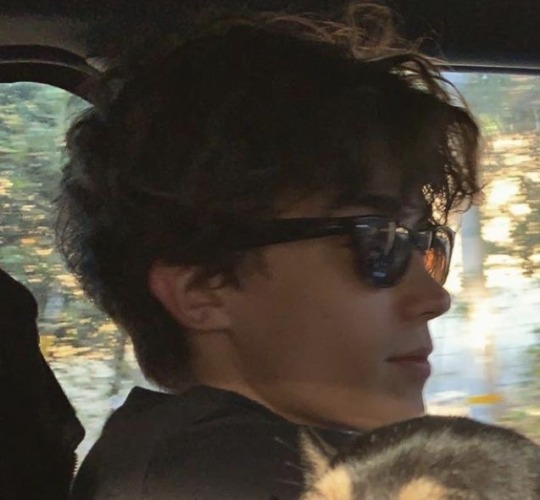



jean kirstein headcanons <3
🎵 cry baby - the neighborhood 🎧

You and Jean had been friends for about a year before you confessed your feelings for each other, and for your one year anniversary, Jean’s gift, alongside the bundle of others he got you, was a notebook full of sketches he had made of you. You only found out how long he’d been drawing them when you realized that the one at the front was you sitting in the lecture where you first met.
a total plant dad. for one of your first dates he took you to a plant market and let you pick out three plants to take with you, which now sit on the windowsill in your shared apartment. (he also named all of them and speaks to them when no one’s around)
his favorite place to paint/draw is outside. in your apartment you have a relatively minuscule balcony, where he can often be found shirtless, letting paints coalesce across a canvas in the early hours.
he likes his coffee strong, will refuse to add sugar to it and tends to lean more towards savory than sweet.
he is the BEST gift giver. he is so thoughtful and will always paint you something for every birthday or gift giving occasion.
he’s very sentimental, harbors a cardboard box under his bed full of photos from high school and various nick nacks he had acquired throughout his life.
loves lamps. he likes a space to be cozy, and turning the overhead light on, to him, is the same as stabbing him in the eyes with a ten inch blade repeatedly. will whine, “noooooo” and bury his face in his arms any time you have to turn it on.
will pay for everything, wont even let you reach for your card, he’s just too fast.
is easily agitated, not by you though, mainly by Connie and Eren who always find a way to torment him on the regular. He blocks them at least four times a week.
loves the colour green. mainly darker shades, bring him a neon and he’ll act as if you’ve shot him.
is like a kid in a candy shop if you take him to an art shop, will take you by the hand and talk your ear off about different painting techniques and consistency’s of paint.
is extremely attentive. will instantly know if you are even so much as a little off. he knows you in and out and will simply ask, “listen or solution?” and will provide service on which you choose.
has a comically large phone, due to his hands. whenever he holds your phone it looks ridiculous.
his mother absolutely adores you, has a groupchat with you and jean where she frequently asks you two to come over for dinner.
he is an extremely cautious driver, this man will never be caught with a speeding ticket. this also manages to drive connie insane because of how fucking slow he is.
“i’m just being careful!”
“yeah okay, grandpa…” 💀
he loves to dance with you, arms wrapped around your waist as you sway to a gentle rhythm, him humming softly in your ear.
your apartment is extremely well decorated due to Jean’s artistic nature. he’s painted the walls, and made sure everything explodes with color. he believes beige home to be the death of interior design.
this also applies to beige babies, jean’s child will be having colorful toys and that’s that.
despite his size, he loves being little spoon. The feeling of your body heat against his spine helps him drift right off.
whenever he’s sick, no matter to what degree he always watches “singing in the rain” - it’s a comfort film to him due to his mother putting it on any time he had the flu growing up.
he adores jazz clubs. he just loves how peaceful and calming they are, and he likes to observe the different types of people who all come together to listen to the sweet hum of a saxophone. a lot of his art pieces are set in that environment.
he has a collection of hand cream. due to his career his hands constantly mirror that of a paint palette, and so, to ensure he doesn’t have cracked hands he always makes sure to moisturize them. his hands are his tools after all, in more ways than one….
you will always be his no.1 muse. a perfect day for him is letting you indulge in any hobby, read, watch tv, cook, bake, and as you do that, he’ll sketch, taking extra time on your eyes and smile. he just truly believes no landscape, no still life, and no composition will ever be as beautiful as what you can make occur on his page. <3

3 aot boy headcanons down, six to go 💋
#jean x reader#jean kirschtein x reader#jean kirstein#jean kirschtein imagine#jean kirschtien#jean x you#jean x y/n#aot imagines#aot fluff#aot x y/n#aot fanfiction#aot oneshots
122 notes
·
View notes
Text
Preliminaries: War of the Utility Wares!
Most pottery you find in archaeological sites isn't painted. Most pottery is unslipped, undecorated utility ware - with the assumption that "utility" typically here means "cooking over a fire." Sometimes grain storage. Usually cooking, though.
It doesn't mean they can't be beautiful in their own right. And one of my friends is working on a dissertation which among other things argues that "surface treatments" like incising and corrugation should be considered "decoration" too, when usually in archaeology "decorated" means "painted." There were lots and lots and lots of types of utility wares. Some were plain. Some were gorgeous.
So this is a Preliminary Round - four different styles traditionally called utility ware will go up against each other... only two will move on to represent utility wares in the final bracket.
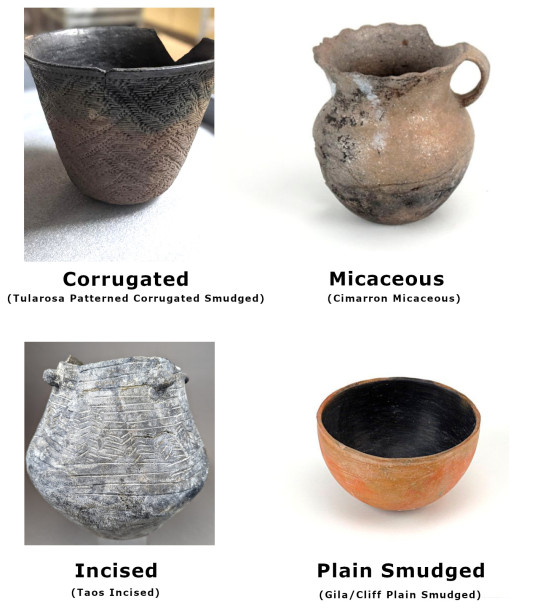
Vote for your favorite: More information about each is under the cut:
Corrugated
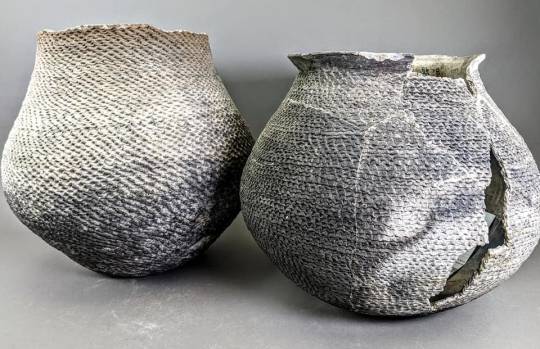
Mesa Verde Corrugated jars. Southern Colorado, AD 1100-1300.
There are SO many different types of corrugated pottery; if I listed them all we'd be here all day. However, they all have commonalities: They were primarily (though not exclusively) made in the Mogollon cultural region, primarily (though not exclusively) plain and unpainted, and primarily (though not exclusively) used for cooking.
In this region, potters don't use pottery wheels. Pots are hand-built, typically from coil-building: using many thin coils to build up the shape of the pot. For most pots, those coils are scraped smooth as they're still wet. But for corrugated pots, those coils are only scraped smooth on the inside. The outside coils are instead pressed using a tool or the potter's thumb to make a patterned, scaled, or woven texture. Corrugation, due to its association with cooking pots, is not typically considered "decoration" by archaeologists, but it creates beautiful and captivating patterns.
Micaceous

Micaceous Bowl with Etched Flowers. Made by Virginia Romero (Taos Pueblo, 1896-1998).
In northern New Mexico, there are golden-red clays with a lot of sparkly mica in them. The mica self-tempers the clay, and creates a lovely shimmering effect when you see the pots in person. There's evidence of polished micaceous pottery being made as early as the 1300s, but it really took off as a popular type of cooking ware in the 1500s-1600s. In this time, it was made primarily by norther Pueblos like Taos, Picuris, and Nambe, but was enthusiastically adopted by the Jicarilla Apache as well, who have strong social ties to those northern Pueblos. Cimarron Micaceous, the handled jar seen above the cut, is a 1600s Apache micaceous pottery style.
Micaceous pottery is still extremely popular with Native potters today. Some of it is as an art form, with many different experiments in structure and style, but some people still swear by cooking in these micaceous clay pots - beans just taste better when cooked in clay instead of metal!
Incised

Taos Incised jar sherd. Northern New Mexico, AD 1050-1300.
Incised ware is SO underappreciated. However I am also biased because for the past three or four summers I have worked on an archaeology project in the Taos area and we find so much of it.
Incised designs are carved into the wet clay. Usually, these are not painted. Incised pottery is very common on the Great Plains, but less so in the Southwest. The Northern Pueblos like Taos and Picuris, however, has long-standing interactions with Plains groups, trading corn and buffalo hides, holding market days together, Picuris and Taos people fleeing the Spanish invasion to live in Kansas with their Apache allies. This is also visible in the sharing of pottery styles in the northern Pueblos, where incised ware is common. Parallel lines that mimic corrugation, chevrons, and herringbone patterns are common.
Plain Smudged

Reserve Plain Smudged, Mogollon Highlands, AD 600-1250.
As I described in my pottery jargon post, "smudging" is a method of getting that shiny black interior during the firing stage. During firing, different levels of oxygen will cause the minerals in the clay to turn different colors. An oxidized environment (high oxygen) turns iron-rich clays red; a recducing atmosphere (restricted oxygen) plus an infusion of carbon turns them black. To smudge a pot, the inside is polished, and then in the firing pit is covered with ash and charcoal. This puts a lot of carbon on the surface, and blocks the oxygen from reaching it. When the pot comes out of the fire, the part that was covered in charcoal will be shiny black. This was another pottery style particularly popular in Mogollon areas.
47 notes
·
View notes
Text



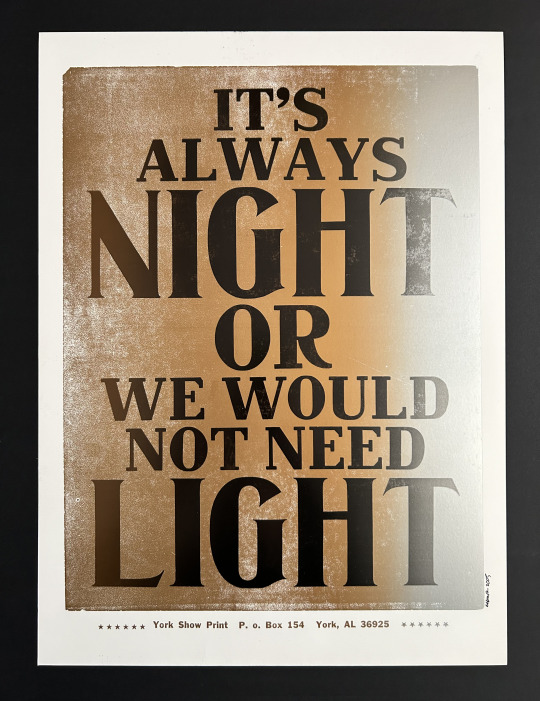

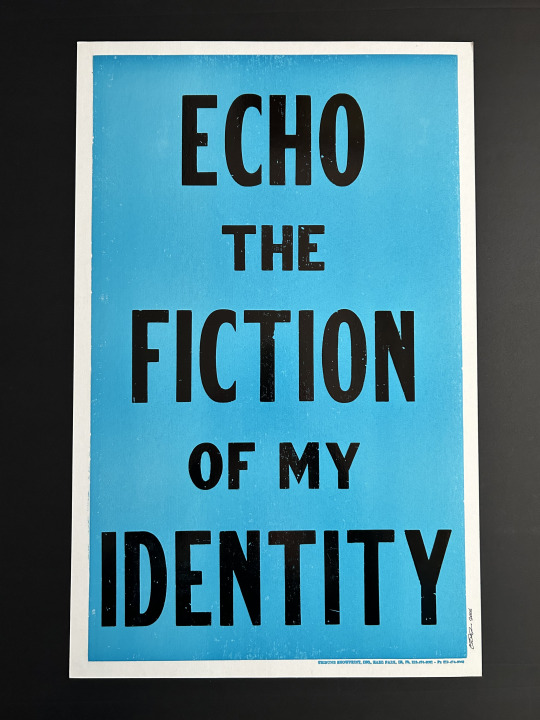
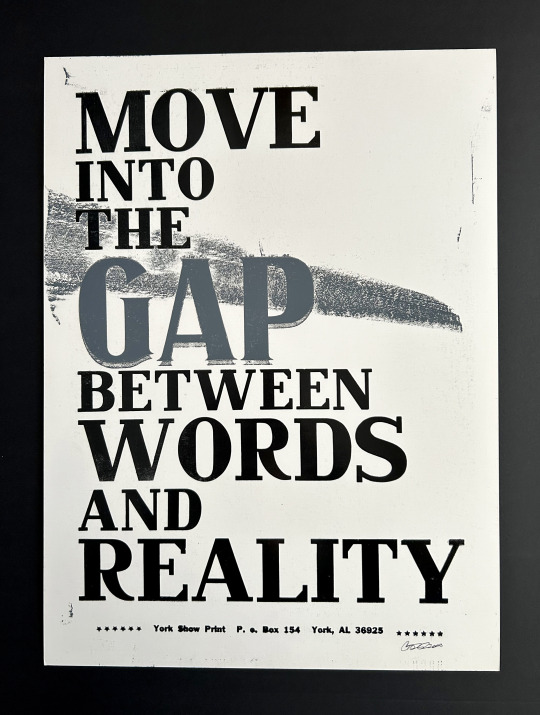

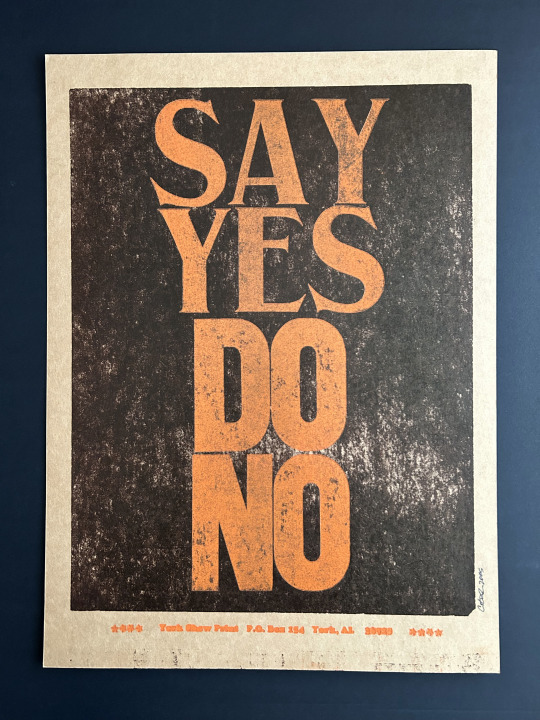
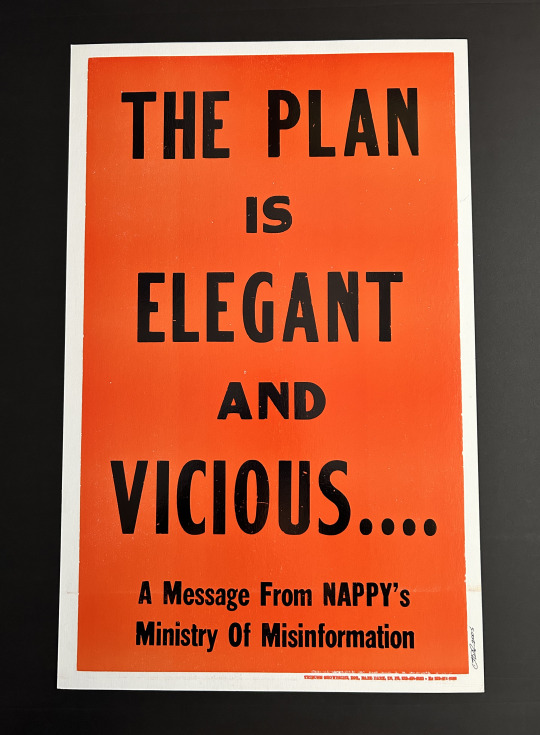
It’s Fine Press Friday!
Today we’re taking a closer look at some of Indianapolis-based artist Carl Pope’s (b. 1961 ) work—a portfolio of broadsides produced for the installation series The Bad Air Smelled of Roses. The edition in our collection consists of 71 letterpress prints of varying dimensions (all around 56 x 36 cm) produced with wood type at York Show Prints in York, Alabama (formerly run by Amos Paul Kennedy, whose works are also represented in our collection) and Tribune Showprint in Earl Park, Indiana (“the oldest continuously operating letterpress shop in the country”) on poster and chip board between 2004-2005, nearly all of which are signed by the artist.
Pope characterizes the work, which has grown since its original iteration to include 108 posters, as “an ongoing essay about the presence and function of Blackness in society” and an exploration of the "various psychological and emotional states like forgetfulness, insanity, alienation" associated with "the poetics of Blackness." He chose to present a selection of texts drawn from a variety of sources including “modern Black literature, René Descartes, jazz and rap music, Sigmund Freud, Malcolm X, Dolly Parton, movie dialogue from Casablanca and The Matrix...” in letterpress print form because of the medium’s historical associations with marketing and political activism.
When installed in the rarified context of an art gallery or museum, as this series has now been exhibited on numerous occasions, the commercial qualities of Pope’s posters incite a productive slippage in our assumptions around high and low culture. As he puts it in a 2018 interview with Hyperallergic, “I don’t see culture as the production of beautiful paintings and works of art, you know, although culture includes that. For me the production of progressive culture is the collaborative practice with myself and other people in the world of ideals, to create and to advance human evolution... I’m not interested in using art as a tool for cultural imperialism.”
View more Fine Press Friday posts.
View Amos Paul Kennedy posts.
View more letterpress posts.
View more wood type posts.
– Ana, Special Collections Graduate Fieldworker
#Carl Pope#fine press friday#letterpress#broadsides#Amos Paul Kennedy#UWM Special Collections#The Bad Air Smelled of Roses#wood type#York Show Prints#Tribune Showprint#poetics of blackness#installation art#Indianapolis#Indianapolis artist#Ana
36 notes
·
View notes
Text
i think it’s really really important that we keep reminding people that what we’re calling ai isn’t even close to intelligent and that its name is pure marketing. the silicon valley tech bros and hollywood executives call it ai because they either want it to seem all-powerful or they believe it is and use that to justify their use of it to exploit and replace people.
chat-gpt and things along those lines are not intelligent, they are predictive text generators that simply have more data to draw on than previous ones like, you know, your phone’s autocorrect. they are designed to pass the turing test by having human-passing speech patterns and syntax. they cannot come up with anything new, because they are machines programmed on data sets. they can’t even distinguish fact from fiction, because all they are actually capable of is figuring out how to construct a human-sounding response using applicable data to a question asked by a human. you know how people who use chat-gpt to cheat on essays will ask it for reference lists and get a list of texts that don’t exist? it’s because all chat-gpt is doing is figuring out what types of words typically appear in response to questions like that, and then stringing them together.
midjourney and things along those lines are not intelligent, they are image generators that have just been really heavily fine-tuned. you know how they used to do janky fingers and teeth and then they overcame that pretty quickly? that’s not because of growing intelligence, it’s because even more photographs got added to their data sets and were programmed in such a way that they were able to more accurately identify patterns in the average amount of fingers and teeth across all those photos. and it too isn’t capable of creation. it is placing pixels in spots to create an amalgamation of images tagged with metadata that matches the words in your request. you ask for a tree and it spits out something a little quirky? it’s not because it’s creating something, it’s because it gathered all of its data on trees and then averaged it out. you know that “the rest of the mona lisa” tweet and how it looks like shit? the fact that there is no “rest” of the mona lisa aside, it’s because the generator does not have the intelligence required to identify what’s what in the background of such a painting and extend it with any degree of accuracy, it looked at the colours and approximate shapes and went “oho i know what this is maybe” and spat out an ugly landscape that doesn’t actually make any kind of physical or compositional sense, because it isn’t intelligent.
and all those ai-generated voices? also not intelligent, literally just the same vocal synth we’ve been able to do since daisy bell but more advanced. you get a sample of a voice, break it down into the various vowel and consonant sounds, and then when you type in the text you want it to say, it plays those vowel and consonant sounds in the order displayed in that text. the only difference now is that the breaking it down process can be automated to some extent (still not intelligence, just data analysis) and the synthesising software can recognise grammar a bit more and add appropriate inflections to synthesised voices to create a more natural flow.
if you took the exact same technology that powers midjourney or chat-gpt and removed a chunk of its dataset, the stuff it produces would noticeably worsen because it only works with a very very large amount of data. these programs are not intelligent. they are programs that analyse and store data and then string it together upon request. and if you want evidence that the term ai is just being used for marketing, look at the sheer amount of software that’s added “ai tools” that are either just things that already existed within the software, using the same exact tech they always did but slightly refined (a lot of film editing software are renaming things like their chromakey tools to have “ai” in the name, for example) or are actually worse than the things they’re overhauling (like the grammar editor in office 365 compared to the classic office spellcheck).
but you wanna real nifty lil secret about the way “ai” is developing? it’s all neural nets and machine learning, and the thing about neural nets and machine learning is that in order to continue growing in power it needs new data. so yeah, currently, as more and more data gets added to them, they seem to be evolving really quickly. but at some point soon after we run out of data to add to them because people decided they were complete or because corporations replaced all new things with generated bullshit, they’re going to stop evolving and start getting really, really, REALLY repetitive. because machine learning isn’t intelligent or capable of being inspired to create new things independently. no, it’s actually self-reinforcing. it gets caught in loops. "ai” isn’t the future of art, it’s a data analysis machine that’ll start sounding even more like a broken record than it already does the moment its data sets stop having really large amounts of unique things added to it.
#steph's post tag#only good thing to come out of the evolution of image generation and recognition is that captchas have actually gotten easier#because computers can recognise even the blurriest photos now#so instead captcha now gives you really really clear images of things that look nothing like each other#(like. ''pick all the chairs'' and then there's a few chairs a few bicycles and a few trees)#but with a distorted watermark overlaid on the images so that computers can't read them
116 notes
·
View notes
Note
1st date asks
For some reason I feel like Carrie would be someone that would enjoy upcycling furniture. With Reggie please.
"Oooh pull over!"
"Um why?" Reggie asked even as he pulled his truck over to the side of the road in the ritzy neighbourhood they were driving through.
Carrie didn't answer, instead jumping out and going towards the pile of stuff sitting at the end of the driveway. Reggie out of pure curiosity joined her.
"Looks like bulk garbage day," he remarked.
"AKA, free loot for us," Carrie stated, handing him a large plastic bin with a wicker pattern with a large crack through the side. "Put that in the truck bed."
"Again...why?"
"I'm gonna fix it up and turn it into a planter for those tomato plants MeeMaw sent us," she replied. "And this dresser is gonna make an excellent make-up table for me," she said, pulling out a dresser with missing middle drawers and boards that used to hold up a mirror.
"You?" Which earned him a glared so he tried to wave off her ire. "Look blossom, I love you, but you don't strike me as the handy type."
"Rich people throw shit out that could be easily fixed or even improved-trust me I know," Carrie replied. "I always wanted to save the stuff my neighbours tossed, but I worried it would look bad. Now I don't care. Plus I had the top grade in shop class-I know my way around a saw."
"I'm no good with tools but I'm a fair hand with a paint brush if you want the help," Reggie offered. "But I draw the line at you bringing in anything with fabric-I doubt either of us want bedbugs."
"Fair enough," Carrie conceded. But she did insist on stopping at a few other places that had interesting pieces laying out.
At home they laid out their treasures, and Carrie went to town caulking, sawing, and hammering away. Reggie sanded and primed what he could, and even surprised Carrie with a thrifted art deco mirror to attach to her new make-up table.
An action that delayed their upcycling, but neither of them minded the break.
"Do you want everything pink?" Reggie asked as he drove to the store to pick out colours.
"I'd rather that to beige or other neutrals, but I'm thinking maybe a nice pastel for the flower bed?"
"Sounds good."
Carrie got to watch Reggie spray and paint all afternoon-from a distance-because the man had seen too many rom-coms where playfully getting your partner with the brush when she would rather he didn't. But she was looking forward to helping him scrub the paint off him later in the shower.
"All done!" he proclaimed exuberantly. "When they're dry we can set everything up."
Later was the next day-they had gotten a little distracted in the shower and then the bed. But Carrie was delighted in her new make-up table, even gasping when Reggie showed her how he had set up little LEDs so the mirror lit up for her.
The planter was set up with tomatoes and a few herbs, plus a trellis they found had little pots of succulents was set up nearby. Neither of them had much of a green thumb, but they wanted to try growing something instead of spending a fortune at the farmer's market every week.
"So what did you think?" Carrie asked later that night as they kicked their feet up on the new coffee table they had fixed up.
"It was more fun than I thought," Reggie admitted. "Would be down to doing it again. But I'm still standing firm on my no bedbugs policy."
"But someone down the street had a thousand dollar couch out on the curb..." Carrie fake whined.
"No."
"I will keep it outside and clean it like a million times."
Reggie sighed, damning his weakness for her. "Fine, but if we get bugs, I reserve the right to tell you I told you so for a year."
"Good enough for me," Carrie stated. "You wanna go see if it's still there?"
"Might as well," Reggie said, heaving himself up off the couch. "It'll be gone if we wait."
Carrie squealed with glee and rushed towards the door, already having her mind race with ideas for her brand new couch.
9 notes
·
View notes
Text
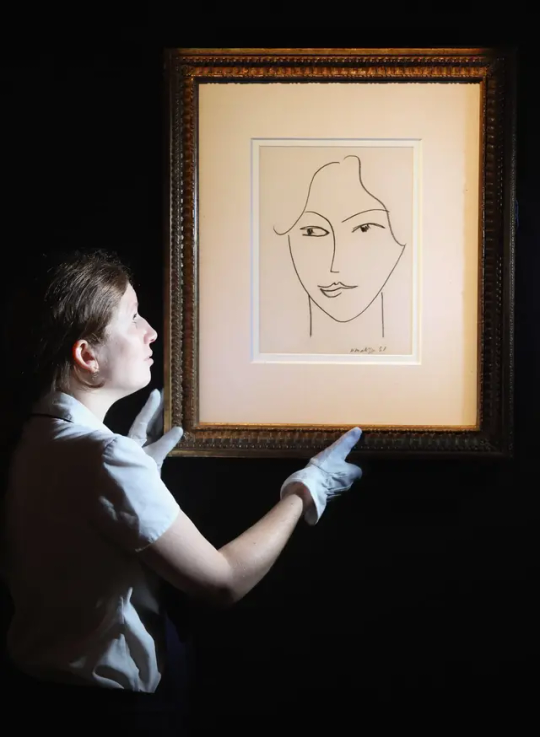
The new tool in the art of spotting forgeries: Artificial Intelligence
Instead of obsessing over materials, the new technique takes a hard look at the picture itself – specifically, the thousands of tiny individual strokes that compose it
In late March, a judge in Wiesbaden, Germany, found herself playing the uncomfortable role of art critic. On trial before her were two men accused of forging paintings by artists including Kazimir Malevich and Wassily Kandinsky, whose angular, abstract compositions can now go for eight-figure prices. The case had been in progress for three and a half years and was seen by many as a test. A successful prosecution could help end an epidemic of forgeries – so-called miracle pictures that appear from nowhere – that have been plaguing the market in avant-garde Russian art.
But as the trial reached its climax, it disintegrated into farce. One witness, arguably the world’s leading Malevich authority, argued that the paintings were unquestionably fakes. Another witness, whose credentials were equally impeccable, swore that they were authentic. In the end, the forgery indictments had to be dropped; the accused were convicted only on minor charges.
The judge was unimpressed. “Ask 10 different art historians the same question and you get 10 different answers,” she told the New York Times. Adding a touch of bleak comedy to proceedings, it emerged that the warring experts were at the wrong end of a bad divorce.
It isn’t a comforting time for art historians. Weeks earlier, in January, the Museum of Fine Arts in Ghent, Belgium, was forced to pull 24 works supposedly by many of the same Russian artists – Kandinsky, Malevich, Rodcheko, Filonov – after the Art Newspaper published an exposé arguing they were all forged. Just days before, there was uproar when 21 paintings shown at a Modigliani exhibition in Genoa, Italy, were confiscated and labeled as fakes. Works that had been valued at millions of dollars were abruptly deemed worthless.
The market in old masters is also jittery after an alarming series of scandals – the greatest of which was that paintings handled by the respected collector Giuliano Ruffini were suspect. A Cranach, a Parmigiano, and a Frans Hals were all found to be forged; institutions including the Louvre had been fooled. The auction house Sotheby’s was forced to refund $10m for the Hals alone. Many experts are now reluctant to offer an opinion, in case they’re sued – which, of course, only intensifies the problem.
Adding fuel to the fire is another development: Wary of being caught, more and more forgers are copying works from the early to mid-20th century. It’s much easier to acquire authentic materials, for one thing, and modern paintings have rocketed in value in recent years.
For many in the industry, it is starting to look like a crisis. Little wonder that galleries and auction houses, desperate to protect themselves, have gone CSI. X-ray fluorescence can detect paint and pigment type; infrared reflectography and Raman spectroscopy can peer into a work’s inner layers and detect whether its very component molecules are authentic. Testing the chemistry of a flake of paint less than a millimeter wide can disclose deep secrets about where and, crucially, when it was made.
“It’s an arms race,” says Jennifer Mass, an authentication expert who runs the Delaware-based firm Scientific Analysis of Fine and Decorative Art. “Them against us.”
But what if you didn’t need to go to all that trouble? What if the forger’s handwriting was staring you in the face, if only you could see it? That’s the hope of researchers at Rutgers University in New Jersey, who have pioneered a method that promises to turn art authentication on its head.
Instead of subjecting works to lengthy and hugely expensive materials analysis, hoping a forger has made a tiny slip – a stray fiber, varnish made using ingredients that wouldn’t have been available in 16th-century Venice – the new technique is so powerful that it doesn’t even need access to the original work: A digital photograph will do. Even more striking, this method is aided by artificial intelligence. A technology whose previous contributions to art history have consisted of some bizarre sub–Salvador Dalís might soon be able to make the tweed-wearing art valuers look like amateurs.
At least that’s the theory, says Ahmed Elgammal, PhD, whose team at Rutgers has developed the new process, which was made public late last year. “It is still very much under development; we are working all the time. But we think it will be a hugely valuable addition to the arsenal.”
That theory is certainly intriguing. Instead of obsessing over materials, the new technique takes a hard look at the picture itself: Specifically, the thousands of tiny individual strokes that compose it.
Every single gesture – shape, curvature, the velocity with which a brush- or pencil-stroke is applied – reveals something about the artist who made it. Together, they form a telltale fingerprint. Analyze enough works and build up a database, and the idea is that you can find every artist’s fingerprint. Add in a work you’re unsure about, and you’ll be able to tell in minutes whether it’s really a Matisse or if it was completed in a garage in Los Angeles last week. You wouldn’t even need the whole work; an image of one brushstroke could give the game away.
“Strokes capture unintentional process,” explains Elgammal. “The artist is focused on composition, physical movement, brushes – all those things. But the stroke is the telltale sign.”
The paper Elgammal and his colleagues November 13, 2017 examined 300 authentic drawings by Picasso, Matisse, Egon Schiele, and a number of other artists and broke them down into more than 80,000 strokes. Machine-learning techniques refined the data set for each artist; forgers were then commissioned to produce a batch of fakes. To put the algorithm though its paces, the forgeries were fed into the system. When analyzing individual strokes, it was over 70% accurate; when whole drawings were examined, the success rate increased to over 80% . (The researchers claim 100% accuracy “in most settings.”)
The researchers are so confident that they included images of originals and fakes alongside each other in the published paper, daring so-called experts to make up their own minds. (Reader, I scored dismally.) One of Elgammal’s colleagues, Dutch painting conservator Milko den Leeuw, compares it to the way we recognize family members: They look similar, but we’re just not sure why. “Take identical twins,” he says. “Outsiders can’t separate them, but the parents can. How does that work? It’s the same with a work of art. Why do I recognize that this is a Picasso and that isn’t?”
The idea of fingerprinting artists via their strokes actually dates back to the 1950s and a technique developed by Dutch art historian Maurits Michel van Dantzig. Van Dantzig called his approach “pictology”, arguing that because every work of art is a product of the human hand, and every hand is different, it should be possible to identify authorship using these telltale strokes.
The problem, though, was that there was too much data. Even a simple drawing contains hundreds or even thousands of strokes, all of which needed to be examined by the human eye and catalogued. Multiply that by every work, and you see how impractical it was.
“It just wasn’t possible to test it,” says den Leeuw, who first became aware of pictology as a student. “I saw many attempts, but mostly it ended in ideas that would never be.”
But can AI now do what humans failed to, and give an art historian’s trained eye some sort of scientific basis? “Exactly,” says den Leeuw. “Very often it’s a gut feeling. We’re trying to unpick the mystery.”
Though Mass says she’s unlikely to throw out her fluorescence gun just yet, she admits to being impressed. “A lot of people in the field are excited by AI It’s not a magic bullet, but it’ll be another tool. And it’s really valuable when you’re dealing with a sophisticated forger who’s got everything else right – paint, paper, filler, all the materials.”
There are issues. So far, the system has been tested mainly on drawings from a handful of artists and a brief time period. Paintings, which generally contain thousands more strokes, are a tougher challenge; older paintings, which might contain numerous layers of restoration or overpainting, are tougher still. “It’s challenging, but it doesn’t mean we can’t do it,” Elgammal says. “I’m confident.”
What about style, though, particularly where an artist changes over time? Think of Picasso’s wildly varying periods – blue, African, cubist, classical – or how in the 1920s Malevich abandoned the elemental abstraction of his black squares for figurative portraits that could almost have been painted by Cézanne (pressure from Stalin was partly responsible).
Another expert, Charles R Johnson, who teaches computational art history at Cornell, is less persuaded – not so much by the AI as by the assumptions that lie behind it. “A big problem is that strokes are rarely individualized,” he says. “Overlap is difficult to unravel. Plus, one must understand the artist’s style changes over their career in order to make a judgment.”
In addition, Johnson argues, many artist’s brushwork is essentially invisible, making it impossible to unpick; it might be better to focus computer analysis on assessing canvases or paper, which can be more rigorously verified. “I remain quite skeptical,” he says.
Elgammal and den Leeuw concede there’s a way to go. Currently they’re working on impressionist paintings – infinitely more complex than Schiele and Picasso line drawings – and hope to publish the results next year. Even with the drawings, the machine can’t yet be left to learn on its own; often the algorithms require human tweaking to make sure the right features are being examined. Artists whose output isn’t large enough to create a reliable data set are also a challenge.
Asking Elgammal if he’s worried about being sued. He laughs, slightly nervously. “That’s something I think about.”
It’s a reasonable question, particularly pressing given the number of fakes that are circulating: What if your database accidentally becomes contaminated? Many people argue that the art market is hopelessly corrupt – so much so that some economists doubt whether calling it a “market” is even fair. Could the algorithm become skewed and go rogue?
“It’s like any system,” Mass agrees. “Garbage in, garbage out.”
Does she think that’s a possibility? How many fakes are out there? “Put it this way,” Mass says, “when I go into auction houses – maybe not the big ones, but smaller, local ones – I think ‘buyer beware.’ It might be between 50 and 70% .”
Rival solutions are coming down the road. Some have proposed using blockchain technology to guarantee provenance – the history of who has owned a work. Others have called for much greater transparency. Everyone agrees that the system is broken; some kind of fix is urgent.
Of course, there are big philosophical questions here. When someone goes to the effort of finding exactly the right 17th-century canvas, dons an antique smock, and paints a near-flawless Franz Hals, it should perhaps make us reconsider what we mean by the words “real” or “fake”, let alone the title of “artist”. Yet the irony is inescapable. It is hard to think of something more human than art, the definition of our self-expression as a species. But when it comes down to it, humans aren’t actually that good at separating forged and authentic in a painting that has all the hallmarks of, say, a Caravaggio but is merely a stunt double. Relying on our eyes, we simply can’t tell one twin from the other. We might even ask: Why do we care?
Forget cars that pilot themselves or Alexa teaching herself to sound less like the robot she is – AI seems to understand the secrets of artistic genius better than we do ourselves.
The irony is that, while machines might not yet might be able to make good art, they are getting eerily good at appreciating it. “Yes, it’s true,” he says thoughtfully. “When it comes to very complex combinations of things, humans are really not so good.” He laughs. “We make too many mistakes.”
Daily inspiration. Discover more photos at Just for Books…?
7 notes
·
View notes
Text
I haven’t been excited by a new toy in a while, but MGA’s new Miniverse got my attention.


These are available everywhere, including Amazon: https://amzn.to/3GGeEIt

However, that’s not always a good thing. It’s not always a positive aspect of a toy that catches my eye.
The big “what???” of these is that they’re marketed to kids age 8 and up, and contain UV resin.
Now..... Resin is
well it’s
...
It’s not for kids.
Allergies to uncured resin are common (both 2-part epoxy and UV resins) and can be severe.
There are lots of warnings in the packaging. I didn’t read them.
You should wear gloves and a respirator when working with any resin, even in a well ventilated area. There aren’t many proper respirators that fit kids....
Froggy on YouTube was too afraid to open her resin and instead used tinted Mod Podge which worked just as well.
I, however, am old and experienced with both types of resin (though no expert), unafraid of the possible reaction I could endure (I’m familiar with resin allergy and how it can be, so a good test subject) so I figured I’d give these a look to see just how bad an idea they might be for kids.
I did NOT wear gloves or a respirator while working on these kits in the name of science.
My first order was 3x of the Diner balls (there are 3x of the Cafe ones on the way).
I wanted a blueberry cheesecake.

None of my three were any type of cheesecake. I got this strawberry and cake parfait, choco-hazelnut spread and strawberry toast, and key lime pie.
First warning on this one: When I opened the little plastic bag that contained the “vanilla cream”, it smelled of UV resin and left my finger sticky. Some resin must have gotten on the outside of the bottle before it was bagged. It did make me itch at the time, which I was like “oh no....” but I’ll get back to that. One of the other balls had the same experience, but not all three.
The positives: Wow this is cute. There are screened veins on the strawberries, the whole berries have painted leaves, and the cake cubes are textured. These are very nice little minis, if a little under-detailed and obviously plastic.
Excellent for doll houses.
Every tiny bottle of resin has a big DO NOT EAT THIS sticker on it with information if you peel it off and unfold it.
The negatives: resin
You get tools, but they’re insufficient. I’ll address that later, also.
The little fruit and cake packages are difficult to open and I tossed my cake cubes across the desk. I am clumsy.
The resin bottle is VERY difficult to open. While this is good to prevent leaks (presumably), it did result in me and various tools being covered in resin trying to get it open.

Most of these items are a good scale for 1/6th dolls (Mini Me is a Live Action Beauty and the Beast Belle head on a curvy Barbie body). That bread is kind of big, those are bulk peanut butter, and that’s a LOT of vanilla cream.
Speaking of the bread...
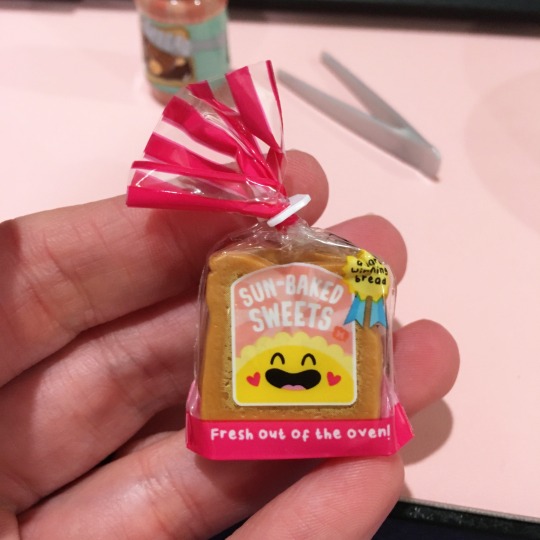
I am NEVER opening this. Never. It’s too cute as it is. There is a TINY. BREAD. TAB.
Never.
That freed up one kit’s stuff to mix with the others.

These limes are transparent like they’ve been baked.

The whipped cream tube opens and there are all of these dollops inside, but I’m not the only one that thought they looked like little garlic! With a little toasty-colored dry brushing they could also be meringues.
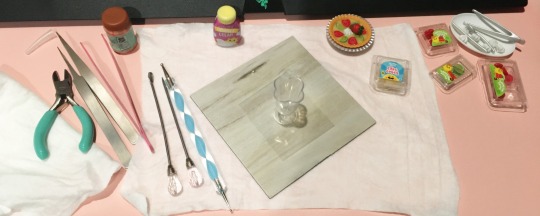
Anyway, this was my “I’ve done this before.” set up. I didn’t tape down my tape (that’s a vinyl flooring sample, it’s an excellent base for working on UV resin), but it was fine for this small project.
I like to work on baby wipes because the damp, rough texture stops things from rolling or sliding around (it’s especially handy if you’re playing with glitter) and I keep another on hand to wipe my tools or my fingers as needed with the container nearby because I do go through a lot of wipes. Negative to baby wipes is that they’re prone to dropping strings everywhere.
Back to the tools.
You don’t want to touch uncured resin. The tools that come with these kits are playscale. Imagine trying to dig the key lime pie goo out of this jar with that tiny knife (though that set comes with a spoon). You’re going to be covered in resin.
There’s only about 1/3 of the jar full.
I used my normal resin doing spoon which is long and still had to stop to wipe my fingers a few times because I am clumsy.

The same with the tweezers.


These longer ones are much safer.

Each of these three kits has a different texture of resin. This is the “Nutella” which is thick and spreadable. I was using it as chocolate sauce since I didn’t want to use the bread. The vanilla cream was runny, and the key lime pie goo was in the middle.
I was doing this at 5 am in the winter so there was no sun. I used my nail lamp, so I can’t say whether these would set properly in the sun.

Having experience with UV resin, I did the key lime pie in two layers, curing the lower layer of just lime goo first so that the pieces wouldn’t get pushed too deep into said goo, then adding a second, thinner layer to set the fruit into.
I got this all over myself even with my longer, more appropriate tools.
Because the deco is plastic you can’t hit the resin with a flame to get rid of bubbles. Sometimes you can get them to pop if you blow on it hard and fast (POOF!) but I didn’t bother.

Obviously I switched mine up and made a strawberry limeade pie instead, using some of the Nutella to make a chocolate dipped strawberry on top.

As for the parfait, I am disappointed that the cake cubes on the bottom are obscured by the resin. It is very runny, ran down and around and covered them right up.
I also did this one in layers. I was wondering if the white resin would be able to cure because sometimes opaque tinted UV resin, especially white, can’t cure and you end up with a thin, cured crust and then that can be easily broken and uncured resin comes out everywhere.
This white resin cured fine. It’s not opaque.
I’m wishing I’d skipped the whipped cream on the parfait because the bright white of the whipped cream makes the transparency of the vanilla cream resin more obvious.
And this is what I’m left with!
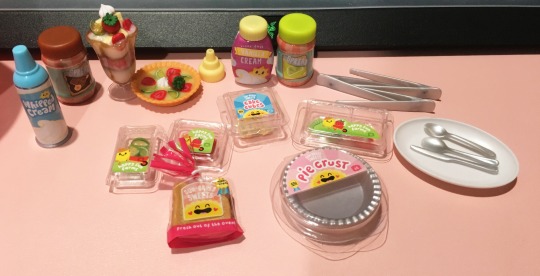
If I hadn’t put the big strawberry on the key lime pie, it all would have fit into the pie crust container.
I cured the mostly empty insides of the vanilla cream and key lime goo containers but not the Nutella because I might come back and use that some day.
Whipped cream bits are back into the can.
I didn’t want to have empty fruit packaging so I pulled out some polyclay canes and refilled them.
Final thoughts
If you were to do these kits as intended, you’d be throwing away most of them. There was a TON of plastic bags inside, three layers of plastic outside, the pie crust and fruit containers and resin bottles/jars would be empty, there are many, many papers inside telling how to use the resin and warnings and the checklist and MGA’s usual “Give us your toy ideas for free!” flyer they include in everything these days.
I didn’t put them in the pictures but each kit does come with a small table that can snap into the ball to use as a dust-free display, and a doily or place mat depending on what you’re making.
I DID get resin all over my fingers. The resin DOES smell, but not as strong as my usual UV resin and it doesn’t sting my nose like my usual UV resin. If I were allergic, I’d be in pretty bad shape right now. As it is, I just feel kind of gross even though I’ve gotten as much off of my hands as I can.
Washing your hands won’t get this off, you need rubbing alcohol, which is where baby wipes come in handy.
Are these for kids 8+?
no
I mean, it depends on the kid. I’ve seen kids that can outcook adults.
Giving this to me at that age or even as a teen would be a mistake. It would end up in my hair, up my nose, on the dog, in my mom’s purse somehow.... I am clumsy.
It depends on the kid, but in general, no. There are very few respirators that properly fit children.
This is for teens and adults who already know how to handle UV resin.
143 notes
·
View notes
Text
My Grandfather’s Betamax and Modelling New Product Diffusion [1] [2]:

My grandfather loved his Betamax camcorder. Sometimes when I picture him he is carrying it with him, casually strung across his shoulder with the rainbow Sony strap (not unlike the one pictured) on display. My grandfather was convinced that Betamax was the superior and bound-to-be enduring technology. I imagine that he thought those home movies would be family heirlooms to be viewed again and again via compatible Betamax players.
I don’t want to paint the picture of my grandfather as naïve. He was well educated (with degrees in Electrical Engineering and an MBA to boot) and a highly successful executive in one of the world’s enduring mega-engineering corporations. Perhaps he would be better characterized as an earlier version of me: be that a more successful, more dignified, more worldly, and much taller version of me. But one thing is for sure, his intuition regarding the staying power of Betamax was wide of the mark. Certainly, we could dissect the various blunders on Sony’s part which ensured that Betamax technology would never achieve market saturation. Yes, it’s easy to Monday morning quarterback most things, but could the right models have been applied to predict, with a measure of accuracy, the rise and fall of Betamax? For that matter, can we model diffusion of new products to untested markets? Take, for example, pre-sliced peanut butter slices, adhesive bandages embedded with nanocrystals of pure silver, a PC plug-in to release scents, a collapsible wheel, and a modified synthetic substance for horse racetracks. While these products sound far-fetched, they all share something in common. They are all 100% real products.
One powerful tool for forecasting the market diffusion of new and innovative products is the Bass Diffusion Model. Prior to Sony’s sale of the first Betamax camcorder (to my grandfather or someone just like him), the existing customer base was exactly zero. As product adoption began, the positive feedback from the handful of early adopters was so minimal that it was negligible, and thus a predictive model such as the Bass model needed to capture alternate adoption channels such as news media coverage, advertising, and directed sales efforts by Sony. To solve this problem, Frank Bass developed the Bass Diffusion Model in 1969 (see sample model diagram below) which solved the start-up puzzle by postulating that potential adopters are made aware of the new product via external information sources which can be modelled as constant over time in terms of magnitude and persuasiveness (effectiveness)[3]. The aggregate adoption rate is the sum of adoptions resulting from word of mouth and adoptions resulting from advertising and external influences.
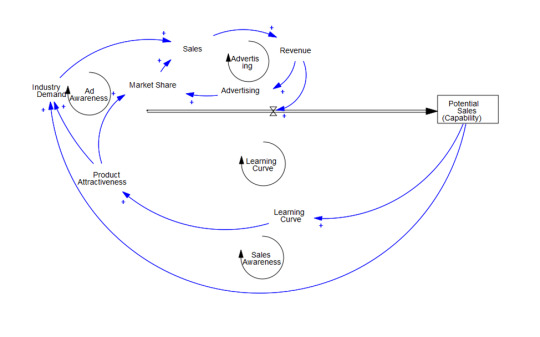
So, what happened to Betamax? Long before it could be cannibalized by superior technology it was dead in its tracks due to inferior technology: VHS (boo!). This was one of the rare times that Sony publicly and massively miscalculated. The popularity of this new technology was largely a function of externalities, specifically the size of the user base. By playing it close to the vest with its new technology, Sony kept the Betamax out of the hands of its competitors. We all know how that played out. Very soon every home had some type of VHS machine, and my family was left to watch my grandfather’s home movies while others were out renting E.T. and Tootsie and all of the other the latest blockbusters. The takeaway messages are numerous: 1) don’t trust your grandfather’s intuition, 2) all models have their limitations, and 3) pre-packaged peanut butter slices are only part of the solution without the jelly slices to go with.

[1] Image sources: image of someone making home movies 1980s betamax - Search Images (bing.com), peanut butter and jelly - Search Images (bing.com)
[2] Content for this article sourced from “Forecasting the Adoption of a New Product” by Professor Elie Ofek and Research Assistant Peter Wickersham, President and Fellows of Harvard College, Copyright 2005; “Four Products: Predicting Diffusion” by Professor John T. Gourville, President and Fellows of Harvard College, Copyright 2001; “Four Products: Predicting Diffusion (2008)” by Professor John T. Gourville, President and Fellows of Harvard College, Copyright 2008.
[3] “Business Dynamics” by John D. Sterman, copyright 2000.
3 notes
·
View notes
Text
okay, mothers and fuckers of the jury. announcement time.
i've made a ko-fi account! for the past few years i've been hesitant to ask for money for my art (i'm no marketer or content creator, and my creative endeavours are so varied, no algorithm would look at me twice on account of having no single box to put me in), but now i'm in a position where extra pocket money wouldn't hurt.
tipping tells me you've seen me, you like what you've seen, and in a way, appreciate that i exist and the things i do.💛
that being said, i want to be able to give back as well. i'd like to take on commission work. these will be for specific types of art, so you know what you're getting. currently, you can order a digital token for your D&D character! for the future, i'm considering offering traditional watercolours (witcher fanart, house portraits), but these take more time and work, so currently we're sticking to digital.
in addition, i have access to a lot of crafting tools and resources, and i've never been more equipped to make stuff i like. so, i'll be selling a few physical things on ko-fi as well. i've put up some paintings already (and my witchy gaming mat design), but you may expect things like hand-bound travel notebooks, ceramics and more original artworks to pop up there. most of those things i will only ship within europe (sorry!)
thanks for sticking around, see you on the dashboard!
#yet another leap of faith!#personal drivel#i'm hoping that approaching it on my own terms will prevent the art burnout of when i tried to be the perfect illustrator artist on ig#i know better now#ko fi#ko fi shop#ko fi commissions#ko fi page
5 notes
·
View notes
Note
arvid dating sim when avid dating sim where
important question: if all of my OCs were in a dating sim who’s route would u pick
Arvid dating sim SOON /j (unless…?)
He is most definitely one of those late stage, ���have to complete one of the main routes first and play his route on the second go through” type of routes, a patch because he was an NPC that people ended up liking a lot.
He’s definitely tricky though, you can only meet with him twice a week at specific times depending on the day, but most of the dialogue choices are pretty easy to get through. The main spots you can find him are really only Dex’s Diner or at the markets getting scrap wood for his work.
On the Festival Day Event ™ you can also find him with all the other Jedi Routes at the Temple’s little market set up running a stand.
Giving gifts/affection items fall as such:
Dislike:
Anything “reptile” print, weaponry, flowers/plants
Neutral
Clothing items (non reptile print), hair care items (brush, ribbon, ties), jewelry
Likes
Food, trinket-like items, sleep items (pillow, blanket, etc), paints and brushes
Hates
Luxury/Very Expensive items, patriotic merchandise (ie: picture of a Senator, republic propaganda posters)
Loves
Hand-made items, tools and wood (Arvid-Only gift)
If the right level of affection is reached he might come over to your apartment to nap or sleep and if you’ve met the confession conditions, His confession event can be played during the new year festival.
#it’s actually also disguised as a sleep tracking app LMAO#Leo tag#kiwikipedia answers#Arvid Cairn (PKWSW)#Dating Sim AU Ask tag#Kiwikipedia OCs
5 notes
·
View notes
Note
Happy WBW! What are the customs around being invited to someone's house in the world of your WIP? (Is it rude for me to bring a gift? Do I have to take my shoes off before going inside? Things like that!)
NOPAL!!! be normal be normal be normal be normal be norm-- I AM SO GLAD YOU ASKED.
[encyclopedia falls through the cut]
ah, shit.
SO, let's go through the aliens i've built so far in Xatal:
**note: these are planetside, traditional living arrangements. when in doubt, ask your host!
Cazen:
Call when you reach the outer bounds of your host's territory -- this is usually marked in some way by a small fence, a garden, or painted rocks. It's polite to announce yourself before the proximity alarm does (so the proximity alarm can be turned off), especially if there are pups napping.
If you're invited over for a meal, make sure your host knows about any special dietary needs before the day of your visit; cazen are accustomed and adapted to living in resource-scarce areas, which means there isn't typically an alternative available, and it's both rude and distressing to invite someone over for a meal and be unable to feed them.
On that note, if you are invited over for a visit, but no meal is mentioned, do not assume you are going to be fed. Resources may be scarce, or as Cazen like to stick with small groups, your host may simply want to catch up for a short period, and then have their house empty of company. You may be asked to stay longer -- there is no social consequence for accepting or turning down this offer.
While not required, if you can spare the credits, you'll get bonus points for asking if your host needs anything from the market/grocer/trader -- even if you're going out of your way to help, it's polite to frame it as if you were "going there anyway."
Uknuks:
Have you been vetted by the patriarch? You're welcome any time. You don't even need to call -- you might not have a "traditional sit-down-and-eat" type of visit, but for an uknuk, spending time together is spending time together. They follow the “friend of my friend is my friend” rule, though, so you may be invited to dinner at a random dwelling. Enjoy!
Bring. A. Gift. It doesn't matter if it's your first time there or your hundredth time. It should be something practical (like tools, nice throw blankets, etc) or food/drinks. Crop seedlings are also accepted, but ask first to make sure they can grow in your hosts' climate, there is room for them in the communal garden, and that they are attractive to local pollinators!! Bonus points for asking what they need, double bonus if you bring something that contributes to the community!
If you're asked to help, you help. The community won't take advantage of someone, and they'll accommodate disabilities and limitations! Usually, if you're taller than 3'... you're on "high" shelf duty.
Don't pick up the uknuks. Don't do it. Unless you're adopted family or a crewmate. And then bully (affectionate) your uknuk "siblings" relentlessly. The kids might try to climb you, though, and in that case, enjoy your armload of fuzzy little babies.
Sodai:
You will be handed the bread vessel. SMASH THE VESSEL. DO IT. There's a round stone on the table. Hold it with both hands, flat side towards the table, and drive it straight down onto the stone. There will be a ruckus. Feel free to scream along.
If you cook bone-in meat close to your visit, save the bones and bring them along! You don't really have to do anything with them either, just shove 'em in a clean bag!
There will probably be fermented meat on the table. You don't have to eat it (you might not even be able to), but try not to make a face.
Post-meal preening and naps are customary! You can turn down the preening, but I guarantee that meal will put you right to sleep!
Ix'ai:
If it's just dinner, you'll be dining out -- research the place you're going to. Follow the dress code, don't over/underdress, look over the menu and have an idea what you're ordering before you go. Your behavior and appearance reflects on your host! No pressure LOL! Forget to look at the menu? Be honest, and ask your host what they recommend 😌 problem solved!
Holiday? Get ready to meet your host's entire family. You will be dubbed gazagaza at the door and held to the same standard as the rest of "the kids." It's fine, you're probably getting a crash course on the ride over -- no, you're not driving yourself there!
Unless asked, don't bring anything but yourself. It implies that the family cannot provide for themselves, and that they're doing so poorly they can't provide for you as well. If asked, it will be a bottle of mid- to top-shelf liquor or a specific wine -- this is for the owner of the house, who your host will introduce you to. This bottle will be opened and served at dinner.
For the love of all that is good and right in the world, do not remove your shoes. Everyone will probably be outside anyway, unless the weather is bad.
Zal:
Ix'ai etiquette on steroids. If you're invited out, you'll be picked up at a specific time (do NOT be late). Ask your host for a meal recommendation and don't offer to pay -- communicate when plans are made that you want to pay for yourself, otherwise just let your buddy spoil you.
If you're invited over, it's a date (romantic or platonic). That's an intimate friends activity! Tell your host they have a beautiful home, remove your shoes if asked (usually dependent on the weather, it's all about keeping the floors clean!), enjoy the tour and the candlelit dinner. It's going to be over the top. Zal like their ceremony!
Don't bring a gift unless you're courting. Bringing a gift is an expression of courting. Yes, even a bag of chips.
As for Other Etiquette:
When visiting someone on a station:
DO ask which dock to use (yes, this goes for public transport as well).
DON'T assume your host is paying for your docking fees or taxi fare, but DO communicate about it ahead of time.
DO offer to bring along a snack or something they can't usually get on the station!
When invited onto someone's ship:
DO greet the captain, if they're not the person who invited you!
DON'T wear strong scents! You're in an enclosed, filtered space!
DON'T bring large gifts, or anything with non-recyclable packaging.
When invited to Eir Terminal, specifically:
If Bax requests your presence, you go right away. You will probably have to wait when you get there, but the important thing is that you are on time.
#listen. i am from the south. etiquette is so incredibly important to me. it's like one of the first things i build.#xatal galaxy#worldbuilding wednesday#once again i have given you an essay
10 notes
·
View notes
Note
I've seen a lot of members in the snzblr-sphere openly condemning gAI and its use. I guess, I wonder how that makes you feel since you use it quite frequently here
Well, this is a sneeze fetish blog but since you asked… here’s a sermonette on AI, lmao:
I work irl in an industry and in roles that have I think fairly significant risk of being displaced by AI in the next 5-10 years, so I have some empathy and understanding particularly for visual artists who feel that all generative AI is parasitical not only on work they and their friends may have done in the past, but in particular harmful to their ability to be paid for their work presently and into the future. And in fact for the purposes of visual art I rarely/never use generative AI anymore, not so much because I found it unethical, but just because it isn’t very good at drawing what I want to see. But like idk if people want me to delete the generative AI images I’ve posted in the past, I would, sure.
I feel quite a bit differently about generative AI text, and that’s probably just cause like… listen, I can’t draw for shit so on some level I don’t really feel qualified to understand how visual artists feel about generative AI, so I think in that sense it’s maybe easier/healthier to defer to practicing artists who feel strongly and otherwise mind my business. But I am a writer, both in the context of this fetish community and irl (technically getting paid—albeit a very small amount—to write for a bit starting at the end of this month, actually!) And for me generative AI is a really effective tool for combating the anxiety of the blank page and virtually nothing else. Like it’s not… good… at writing? And because I’ve used it so much I currently don’t have any fear of it becoming good enough at writing to replace professional writers? (Also at a deep level, I do believe that novel ideas and perspectives exist and the core social utility of writing is to provide those new ideas and perspectives, which I just don’t think generative AI is capable of doing, at least not any time soon). But on some level that makes it perfect for churning out endless variations on simple sneeze fetish themes that land in our silly fetish horny hitboxes. So because it is not capable, in my opinion, of replacing professional writers even for basic corporate marketing type shit, I see it more as a tool for writers to use as we see fit? And I have zero problem using the tool to recreate slight variations on the theme of “big sneeze blows things away” to satisfy fetish cravings and frankly I think y’all should use it in the same way lmao. And also use it to help you write actual stories! It works well as essentially an outlining tool. I wouldn’t even use it to generate dialogue or language because again I think it is very bad at that, but it is good at like… providing options for how a story could flow from point a to point b. And sometimes just revising something is easier than starting from scratch, you know?
AND THEN more broadly, I don’t think that generative AI is inherently harmful, I think we (as Americans/westerners/consumers in capitalists societies, not as sneeze fetishists lmao) have a social structure that makes it potentially harmful. The issue with generative AI taking your job isn’t that it’s going to replace your true original artistic expression, your brilliant webcomic, your sprawling fantasy universe, your masterpiece painting. The issue is that it’s going to take your bullshit graphic artist job for a marketing firm, or even your job as a storyboard artist, etc. AND maybe it SHOULD take those jobs! If gAI can speed up the intermediate stages of artistic production like storyboarding, then great storyboard artists can simply work on more films, enhancing the quality of those films, by using AI to speed up their work. And for the marketing gig, if that work that frankly does more to sap creative energy and funnel it towards greasing the bullshit wheels of capital could be done by generative AI, that would be GREAT for artists, *if* the value created were shared equitably across society. If there were an “AI dividend” that took 50% of the savings created by generative AI and invested it in grants and free classes and free drawing tablets and free housing and funds for creatives to do creative work, then you wouldn’t need the bullshit marketing job that saps your energy, you could work part time in a job unrelated to art and still afford the necessities of life while you work on the stuff you actually care about.
But, of course, we have a bullshit capitalist system. But even within the confines of that system, trying to just reject a productivity enhancing technology rather than harnessing it to the benefit of workers (rather than just allow capital to use the technology as it sees fit, which we have seen unions like the WGA in particular fight very effectively against, SAG-AFTRA less so but that’s a whole other can of worms) is, imo, always a fool’s errand. What we need isn’t to ban AI or create taboos against its use; what we need to emphasize that it is a tool for creatives to accelerate our work, to create more time for us to attend to the details, to ultimately help us make better stuff (and here I am lowkey or maybe high key talking about my day job tho I am being intentionally vague) rather than simply a way for capital to cut down on labor costs. Don’t hate the new robot player, hate the game lol. And in all seriousness, *organize* so that the game gets better rules. And share some of the benefits with capital too, because that’s how it works in the mixed economy (for now). AI generally is eventually going to automate away a lot of junior and entry level work in my industry… and I actually think that can be GREAT! Because then junior level people can actually be apprentices to the creatives that are doing the jobs they one day want to do, instead of getting stuck (as I did, for nearly a decade) doing boring technical work under the guise of assisting creatives, but not actually getting any better at the creative skill you are supposedly apprenticing to one day do.
“But bigsnzstanacct, what if I really love my marketing job greasing the wheels of capital using graphics and art work?” you say. Awesome! Then you should be mastering generative AI to get the most possible benefit out of it, because After The Revolution, we will need people to get the best out of the generative AI and touch up their work and fix their errors either inside or outside of the gAI programs. That is also part of how we harness AI to actually benefit society, by getting good at using it.
So anyway, sermonette over tl;dr: message me or send me another ask if you want me to delete my old posts of generative AI images; generative AI and AI as a whole is just a tool, the tool in itself is not good or bad, the institutions shaping its use are good or bad (and the capitalist institutions that dominate workers presently are very very bad and will incline towards using AI badly and in an anti-worker way in already precarious creative fields, BUT there is power in a union, and we can work together to improve the institutions such that AI can benefit us all, perhaps creatives especially.)
5 notes
·
View notes